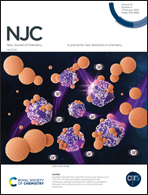Unveiling the catecholase activities and DNA binding interaction of mono-, di-, and polymeric Cu(ii) complexes derived from heterogeneous Schiff base ligands†
Abstract
In this study, a comparative study of the catecholase activities and DNA binding of three Cu(II) complexes is described. These complexes are mono-nuclear (1), di-nuclear (2), and poly-nuclear (3) complexes of Cu(II) bound with NNN and NNO tridentate Schiff base ligands. The general formulae of these complexes are [Cu(L1)Cl2] (1), [Cu2(L2)2(μ1.1-CH3COO–)2] (2) and [Cu2(L3)2(μ-N3)(N3)]n (3), where L1, L2 and L3 are heterogenous Schiff base ligands. CT-DNA binding properties of the complexes were studied using UV-vis and fluorescence spectroscopic techniques. Molecular docking studies were performed to gain deep insight into the binding regions of the complexes to DNA. All three of the complexes can effectively catalyze the oxidation of 3,5-ditertiarybutylcatechol (3,5-DTBC) in methanol to its corresponding quinone in the presence of aerial oxygen with first order reaction kinetics that follow Michaelis–Menten enzymatic kinetics with turnover numbers 5.1 × 105 (1), 4.52 × 105 (2) and 4.66 × 105 h−1 (3). Moreover, absorption, fluorescence, and viscosity studies show the possibility of partial intercalative binding of the three Cu(II) complexes with CT-DNA. This binding may be exploited to determine an unknown concentration of DNA and to judge the efficiency of these complexes when investigated in the future as components of pharmaceutical drugs.



 Please wait while we load your content...
Please wait while we load your content...